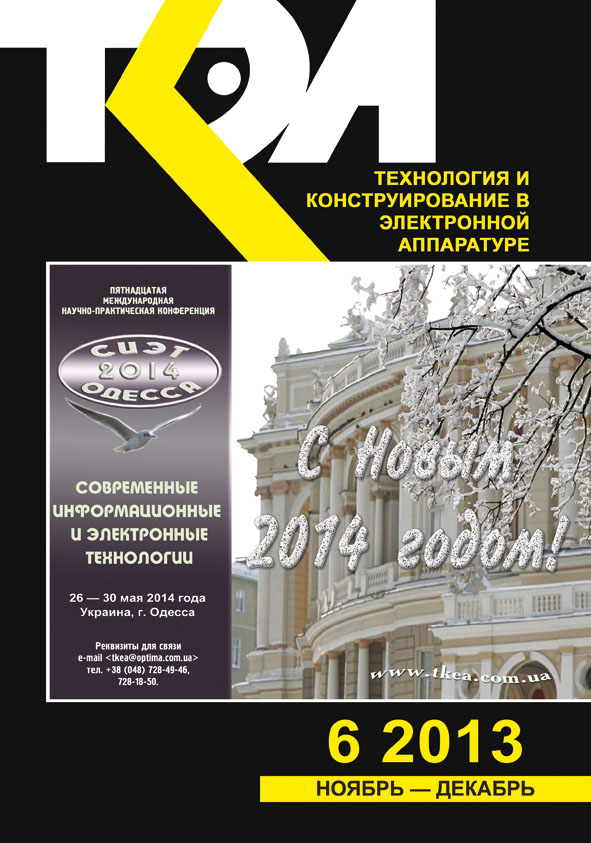Obtaining porous silicon suitable for sensor technology using MacEtch nonelectrolytic etching
Abstract
The author suggests using the etching method MacEtch (metal-assisted chemical etching) for production of micro- and nanostructures of porous silicon. The paper presents research results on the morphology structures obtained at different parameters of deposition and etching processes. The research has shown that, depending on the parameters of deposition of silver particles and silicon wafers etching, the obtained surface morphology may be different. There may be both individual crater-like pores and developed porous or macroporous surface. These results indicate that the MacEtch etching is a promising method for obtaining microporous silicon nanostructures suitable for effective use in gas sensors and biological object sensors.
References
Bisi O., Ossicini S., Pavesi L. Porous silicon: A quantum sponge structure for silicon based optoelectronics. Surface Science Reports, 2000, no 38, pp. 1-126.
Pavesi L., Turan R. Silicon nanocrystals. Fundamentals, synthesis and applications. Weinheim, Germany, Wiley-VCH, 2010. https://doi.org/10.1002/9783527629954.ch1.
Kilian K.A., Bocking T., Lai L.M.H. et al. Organic modification of mesoporous silicon rugate filters: The influence of nanoarchitecture on optical behavior, Int. J. Nanotechnol, 2008, vol. 5, no 2/3, pp. 170-178. https://doi.org/10.1504/IJNT.2008.016914
Iatsunskyi I., Smyntyna V., Pavlenko N., Sviridova O. Peculiarities of photoluminescence in porous silicon prepared by metal-assisted chemical etching, ISRN Optics, 2012, аrticle ID 958412. https://doi.org/10.5402/2012/958412
Ben-Chorin M., Kux A. Adsorbate effects on photoluminescence and electrical conductivity of porous silicon, Appl. Phys. Lett., 1994, no 64, pp. 481-483. https://doi.org/10.1063/1.111136
Galeazzo E., Peres H.E.M., Santos G. Gas sensitive porous silicon devices: Responses to organic vapors, Sens. Actuat. B., 2003, no 93, pp. 384–390. https://doi.org/10.1016/S0925-4005(03)00200-4
Barillaro G., Diligenti A., Nannini A., Strambini L. Low-concentration NO2 detection with an adsorption porous silicon FET, IEEE Sensors. J., 2006, no 6, pp. 19-23. https://doi.org/10.1109/JSEN.2005.859360
Pavlenko N. N., Yatsunskyi I. R., Smyntyna V. A. et al. [Applying of porous silicon obtained by metal-assisted chemical etching in sensors and microelectronics] Proc. of the 14th International scientificpractical conference “Modern information and electronic technologies”, Ukraine, Odesa, 2013, pp. 214-216. (Rus)
Smyntyna V, Iatsunskyi I., Sviridova O., Pavlenko N. Photoluminescence properties of nanostructured silicon fabricated by metal-assisted chemical etching, Frontiers in Optics Conference, 2012, OSA Technical Digest (online), paper FTu1A.6.
Balasundaram K., Sadhu J.S., Shin J.C. Porosity control in metal-assisted chemical etching of degenerately doped silicon nanowires, Nanotechnology, 2012, vol. 23, no 30, pp. 305304-305311. https://doi.org/10.1088/0957-4484/23/30/305304
Harada Y., Li X., Bohn P.W., Nuzzo R.G. Catalytic amplification of the soft lithographic patterning of Si. Nonelectrochemical orthogonal fabrication of photoluminescent porous Si pixel arrays, Journal of the American Chemical Society, 2001, vol. 123, no 36, pp. 8709-8717.
Huang Z., Geyer N., Werner P. et al. Metal-assisted chemical etching of silicon: a review, Mendeley, 2011, no 23, pp. 285-308.
Iatsunskyi I.R., Smyntyna V.A., Pavlenko N.N. Ammonia detection using optical reflectance from porous silicon formed by metal-assisted chemical etching, Proceedings of SPIE “Defense + Security”, vol. 8901A, Germany, Dresden, 2013, paper 8901-20. https://doi.org/10.1117/12.2028497
Copyright (c) 2013 Iatsunskyi I. R.

This work is licensed under a Creative Commons Attribution 4.0 International License.

